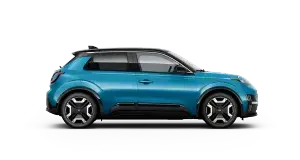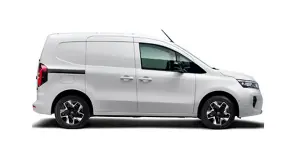Nissan LEAF 2023 Owners Manual
4.3.2.8. Normal charge with NISSAN EVSE (where fitted)


- B1Domestic plug
- Insert the outlet plug into a dedicated 220 – 240 V AC power outlet
- B2Safety cap
- Be sure to refit the safety cap once charging has finished
- B3Release button (where fitted)
- B4Control box indicator lights
The NISSAN EVSE with domestic plug is primarily intended for use with public charging stations, and provides 8-10 Amperes AC power to charge the battery.
When using the NISSAN EVSE with a domestic electrical socket, it is important to understand that the LEAF draws a high continuous electrical current which could lead to concerns if the electrical wiring and socket do not comply with the latest National Regulations; have been incorrectly installed; or not properly maintained.
Your NISSAN electric vehicle dealer can provide full details of our partner Electro-Mobility Operator (EMO) in your country who can give you guidance on the best way to charge your NISSAN LEAF.

Do not use any electrical socket which does not comply with the latest National Regulations to charge your NISSAN LEAF.
If your house’s electrical system is old or has not been inspected recently we strongly recommend that you get your wiring and socket inspected by a qualified electrician before charging.
Do not use extension cables because most extension cables cannot carry the required current and might get hot.
Do not use adapters as the NISSAN EVSE is not designed to be used with adapters and might get hot.
Ensure that your NISSAN LEAF is charged on a dedicated circuit.
A dedicated circuit is a line from the circuit breaker with no other electrical sockets.
Most detached garages will be supplied by a dedicated circuit but often sockets inside the house are on a ring main.
Ring main sockets can become overloaded from other electrical devices that are plugged in at the same time as the LEAF which will trip your electricity supply.
If there are any signs of wear, damage or discoloration, do not use the socket for charging.
Inspect socket regularly and replace if there are any signs of wear, damage or discoloration.
If you have any doubt regarding the capacity of the socket or wiring, do not charge your NISSAN LEAF until you have confirmed the outlet’s suitability by consulting your Electro-Mobility Operator (EMO) or a qualified electrician.
Do not disassemble, repair, or modify the EVSE.
Do not use an extension cord or adapter for charging.
Do not touch the plug with wet hands.
Do not touch the electrical terminals of the EVSE.
Do not touch a vehicle or the EVSE if you hear thunder.
If you have a pacemaker or implantable cardioverter-defibrillator (ICD) implant, keep a distance of at least 15 cm (6 in) between you and the EVSE control box.
Do not allow a child to handle or use the EVSE without adult supervision.
Precautions on handling the EVSE
Do not pull, twist, bend, step on, or drag the cable and/or cord.
Do not wind the cable and/or cord around objects such as the normal charge connector and/or control box.
Hold the main body of the plug and securely insert it straight up as far as the base.
Do not pull on the cord to disconnect the plug.
In the event of an abnormality or problem:
Do not use the EVSE when there is an abnormality or problem, such as a deep cut, crack, or damage, or if the plug is corroded.
If charging stops when you move the plug or cord, this may be caused by a line breakage. When this happens, immediately stop using the EVSE.
Immediately stop using the EVSE if you notice an abnormality or problem such as a strange smell, smoke, or unusual noises being emitted from the EVSE while charging.
Precautions on the domestic outlet
Use a grounded domestic outlet that complies with standards and regulations.
Do not use an domestic outlet if the plug is loose when inserted in the outlet or if there is damage or corrosion on the outlet side.
Ensure electrical supply is AC 220 - 240 V 50 or 60 Hz.
Before you connect the EVSE be sure to check the rated current shown on the EVSE to ensure that the domestic outlet and circuit has enough current capacity to charge your vehicle safely.
The EVSE draws a constant 8-16 Amperes, you must ensure that the domestic outlet and household wiring used for charging is rated at this level and complies with the latest electrical wiring standard and regulations in your country or area.
Max current rating depends on country.
If in any doubt about the domestic outlet and circuit, consult a qualified electrician.

Be sure to connect the EVSE to an domestic outlet with the rated voltage only.
Precautions on storing the EVSE
Do not store the EVSE in a place exposed to direct sunlight.
Do not store the EVSE in a place exposed to wind and rain.
Be sure to store the EVSE with the protective cap on to keep the terminal part of the normal charge connector away from dirt and dust.
Do not store the EVSE with the cable and/or cord wound around the control box.
Do not store the EVSE in a condition in which the cable and/or cord are twisted.
The control box will become hot while the EVSE is charging. This is not a malfunction.










